
African Influence on Judaism

Judaism is the precursor to the two Western religions of Christianity and Islam. The creators of this religious system are known as Hebrews. The term often used to refer to the Hebrews is "Semitic." This word however has varying meanings denoting either race, ethnic group, language, or a combination thereof. In ancient Egypt they are clearly depicted as Semitic types. Yet as late as the Roman period there are references to Hebrews being compared to Ethiopians and Egyptians. It is most likely then to conclude that the ancient Hebrews derived from an ethnically diverse group such as Hittites, Amorites, and Canaanites, who perhaps intermixed with African types through a variety of means, perhaps during the New Kingdom era when Egyptian and Nubian troops were regularly in the region. |
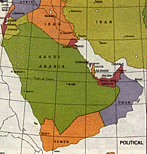
When Jospeh H. Greenberg in the late 1940s set about the monumental task of classifying African languages, the origins of Hebrew were probably far from his mind. Five years later even he would be astonished at his findings. Of the many groups Greenberg placed together, the Hamito-Semitic yielded the most astounding finds. Greenberg had identified five different branches of Hamito-Semitic: Cushitic, Egyptian, Berber, Chadic and Semitic. It was always assumed that the relationship of these languages stemmed from Caucasian invaders into Africa from the Middle East. But Greenberg's research far from supported this. Greenberg realized that the Cushitic branch languages were far more divergent from each other than were those of any other branch. Such sharp differences indicated that the sub-branches of Cushitic had diverged from each other at a very early date and had been evolving independently for much longer than any of the other branches. This all implied that the Hamito-Semitic language was evolving in Cush (Ethiopia) longer than anywhere else. Thus Ethiopia had to be the original homeland of all Hamito-Semitic languages. It is now believed that perhaps as early as 12,000-10,000BC, African proto-Cushitic speakers migrated from Ethiopia spreading out into Africa and the Near East. This proto-Cushitic tongue evolved not only into Cushitic, Egyptian, Berber, and Chadic tongues, but into the Semitic branch as well. This included Hebrew, Phoenecian, Arabic and Assyrian. Thus the Hebrew tongue is of rather recent (prehistorically speaking) African origin. Greenberg renamed this Cushitic derived family group more appropriately, Afroasiatic. It is not surprising then that Hebraic religion can be found with so many African mythic symbols. The picture above illustrates the close proximity of East Africa and the Near East or "Biblical World." (Photo and Information courtesy of Time Life World Maps, Black Spark, White Fire by Michael Poe, Languages of Africa by Joseph Greenberg and the Afrocentric Debate Research Page) |
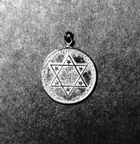
The Hebrews were a small nomadic tribe located in a land of giants. All about were immense and powerful nations in Africa and the Near East. It is not surprising then that the Hebrews were so heavily influenced by the splendor they saw about them. If the ruins of these nations still hold us in fascination today, imagine the awe of the nomadic shepherd gazing upon the Great Pyramid or Her-Em-Akhet (Sphinx) for the first time. It is generally conceded the Kingdom phase of Hebrew history was an influence of the many kingdoms about them. This influence upon the Hebrews can be most seen in the figure of Moses. It should be noted that the story of Moses, real or imaginary, tells us very much the importance Africa played in Hebrew religion. It must be remembered that Moses, mythic or real, was said to be "learned in all the ways of the Egyptians." Above is the symbol of Judaism, the Magen Star. The geometric symbol of two overlapping triangles is thought to be of Afro-Egyptian origin. Within can be seen the poles, the tropics and the ecliptic. This symbol is especially important to the
esoteric Hebrew sect known as the Cabala. It is interesting to note that the Cabala holds a similar sound with the Ka and Ba, the two parts of the Egyptian soul. (Photo and Information courtesy of Judaism page, African Origins of Western Religions by Dr. Yosef-ben Jochannan, and Man, God and Civilization by John G. Jackson)
|

In the first book of Moses, Genesis, the earth's description as "dark and without form" has its origins in African creation mythos. Thousands of years before Genesis was written, the Nilotic Egyptian Nu was the feminine chaotic, dark, formless, watery manifestation from whom all Creation sprang. Just as the spirit of God moved across the waters in Genesis, so did the Egyptian manifestation of air, Shu, move across the waters (Nu). And long before Adam was molded from the Earth, the Egyptian manifestation Khunum molded man from clay. Long before Adam was the first man made in God's image, the Egyptian manifestation Atum rose from the waters of Nu to become the first being in the form of God. In Hebrew the first woman was Eve, which in Hebrew is Havvah, who was seduced by a serpent. Havvah in Egyptian is Hefa, the Great Mother Serpent of the world. Thus the greatest stories of Genesis, that of the Creation and Eve and the serpent, are set to unfold. Pictured above is the Egyptian deity Ptah, "Grand Architect" and "Creator of the Universe" in the Memphite Theology. (Photo and Information courtesy of Judaism page, African Origins of Western Religions by Dr. Yosef-ben Jochannan, , Egyptian Mythology Page and Man, God and Civilization by John G. Jackson) |
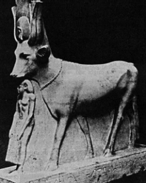
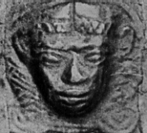
The Hebrew religion was filled with a host of Egyptian deities. One of the most known of these was the sacred Golden Calf of the Exodus saga. This so-called "idol" was in reality the Egyptian manifestation Het-Heru, which originated from the strong cattle culture which permeated much of Africa. Depicted as a nurturing cow with a sun disc, she was the guardian of marriage, the donor of life and protector of the dead. She was heralded as the giver of joy, love, sensuality, song, music, and dance. Het-Heru may at one time have been the most important deity to the Hebrews. With the coming of Mosaic law, she was replaced by an all powerful male deity, Yahweh. Thus the Exodus story of the Golden Calf may allude moreso to the coming patriarchal aspects of Judaism and Hebrew nationalism than idol worshipping. Het-Heru was also associated with the moon, also seen as feminine. It is interesting to note that in Egyptian Yahweh means "the growing moon." Pictured above is the Golden cow representing Het-Heru. To the right is face of Het-Heru found interestingly enough not in Egypt proper, but the Sinai peninsula: a known area of Hebrew occupation.(Photo and Information courtesy of Judaism page, African Origins of Western Religions by Dr. Yosef-ben Jochannan, and Man, God and Civilization by John G. Jackson)
|
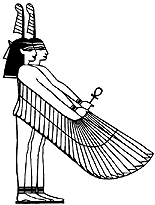 |
Other probable Egyptian contributions to Hebraic culture include the practice of circumcision, and baptism, both traditional African practices. The name Moses itself is Egyptian and means, "baptized by water." Maat was said to have 42 moral laws which were to be declared by the deceased in order for them to be judged. These laws were not only for the common individual, but for everything in the universe to obey. It is thought by some that Maat's 42 laws may be the source of the Hebraic Ten Commandments. Pictured is Maat in her winged form. Some also argue that Maat may be the source of the Hebraic notion of angels (with a Canaanite link) as they appear nearly identical on the famous Ark of the Covenant.(Photo and Information courtesy of Judaism page, African Origins of Western Religions by Dr. Yosef-ben Jochannan, Man, God and Civilization by John G. Jackson, Egyptian Influence on Israel Page, Moses and the Egyptian Priesthood Page) |
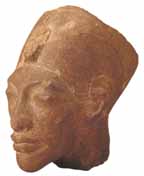
That which so typifies Hebraic religion is its staunch monotheism. This is an attribute generally attributed to the Hebrews and the western religious systems. It could be argued that many African religions were also monotheistic. The Egyptians held that Neter was the Supreme Being above all other gods. The Yoruba of West Africa said much the same of Oldumare. The difference with the Hebraic version is its strong disassociation with all other deities in favor of one Supreme Being. But this spiritual ideology which we can term, "total Monotheism," had existed elsewhere. The ruler Akhenaton is known to have begun a spiritual reformation in Egypt around 1350BC. This reformation did away with the entire Egyptian pantheon, replacing them with one Supreme Being known as Aten. Akhenaten, born Amenhotep IV, even changed his name to reflect his new found "total Monotheistic" deity. Akhenaten's heresy was short lived however as political and social pressure forced him to return to traditional Egyptian spiritual practice. Many have speculated if perhaps the Hebrew idea of "total Monotheism" was derived from this earlier version some 300 years older. Pictured above is the heretic king Akhenaten(Photo and Information courtesy of African Origins of the Western Religions by Yosef-ben Jochannan, Man, God and Civilization by John G. Jackson,Nile Valley Contributions to Civilization by Anthony T. Browder and The Complete Akhenaten Page)
|









